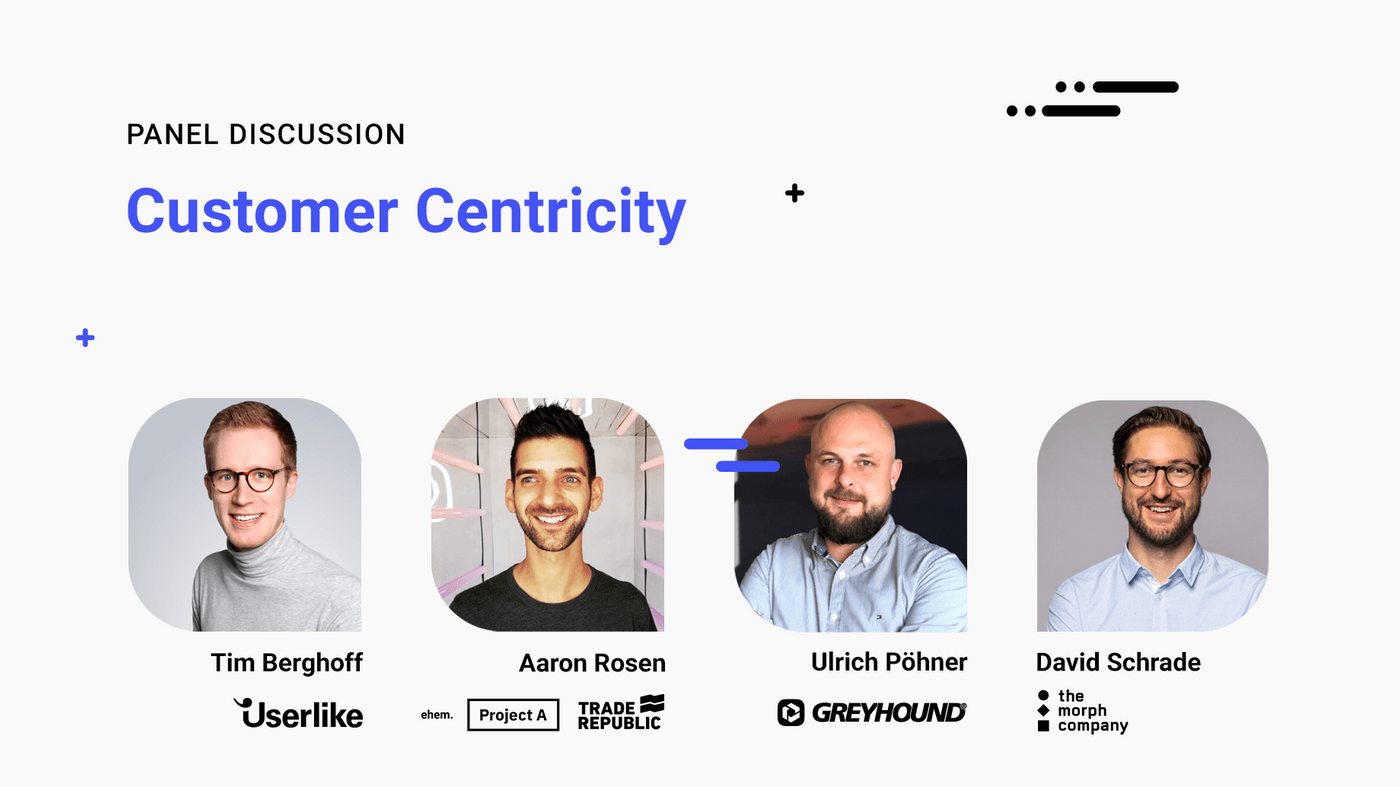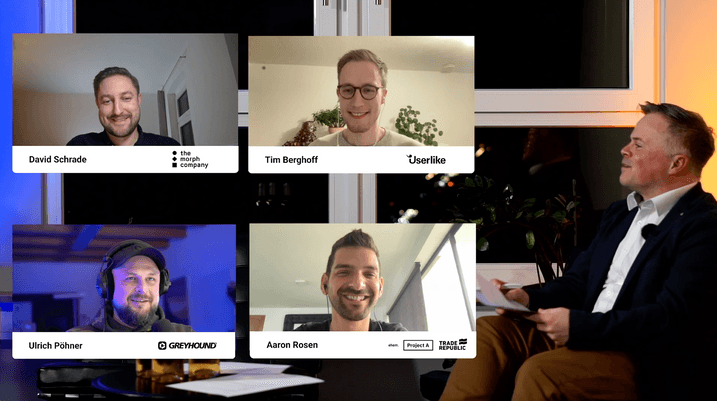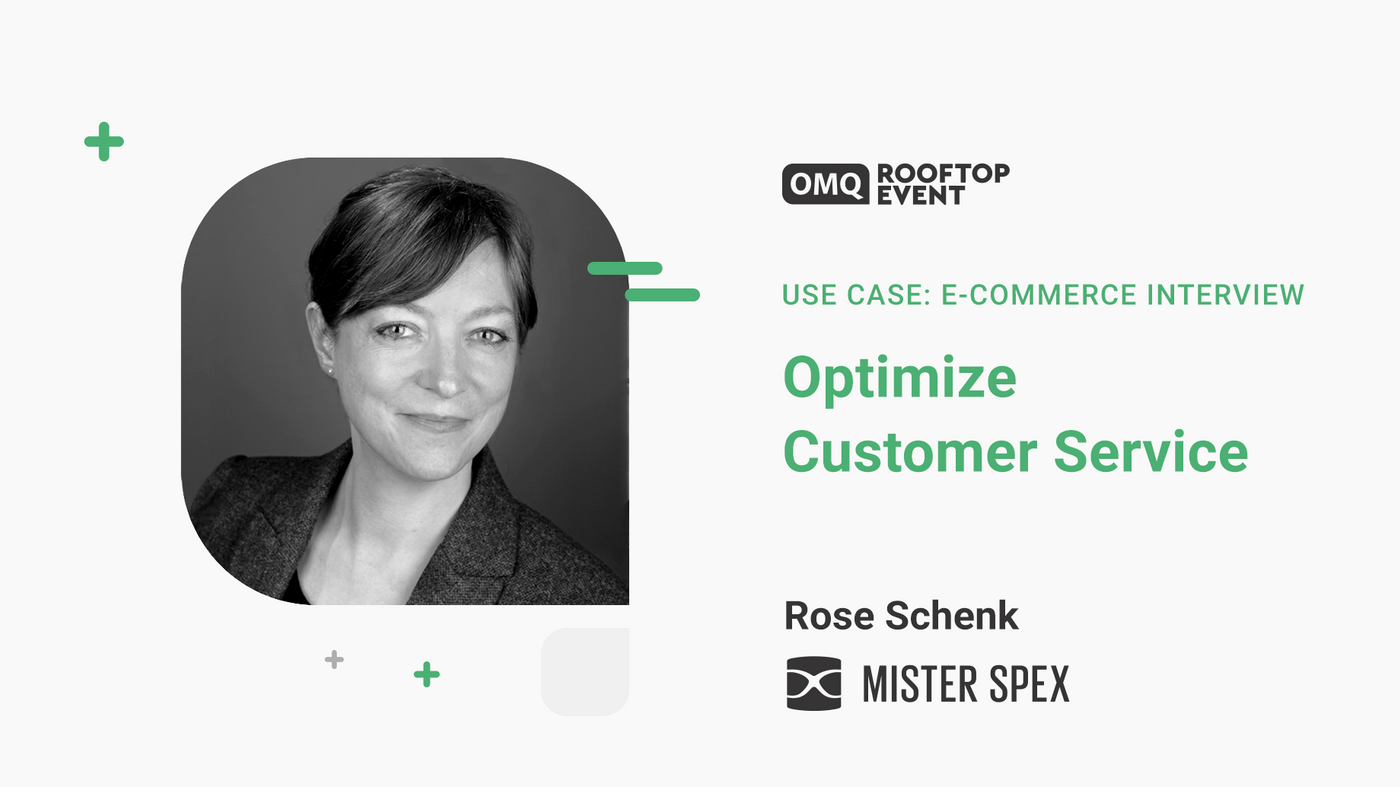Professional Voices
Building Customer Relationships with the Help of Customer Centricity | Expert Opinions
Customer centricity' is an important keyword in customer service, which is why we invited experts from the fields of marketing, CRM, customer consulting and software development to talk about customer centricity and communication channels.

Successful business models are often based on the ability to build customer relationships and maintain them in the long term. Customer centricity is an important topic, because it increases customer loyalty and satisfaction. The latter can be doubled in customer centricity.
In our panel discussion at the rooftop event 2022, our CEO Sven Engelmann talked about customer centricity with our guests David Schrade (the morph company), Tim Berghoff (Userlike), Ulrich Pöhner (Greyhound Software) and Aaron Rosen (formerly Project A & Trade Republic).
Part of our discussion are…
On the strategic level:
Aaron Rosen: Aaron supports companies as a freelance consultant in the field of marketing strategy/growth and CRM. Previously he was at Project A where he was involved in CRM, social media and marketing. He also built up growth marketing at Trade Republic. According to him, marketing must always be customer-centric, which many companies ignore.
David Schrade: As founder and managing director of the morph company, David advises companies and accompanies their transformation processes. He finds that customer centricity can also be described as employee centricity, whereby employees should be supported in every digital transformation and change. Before joining the morph company, he taught at the Hasso Plattner Institute. His thesis: The human being at the centre of customer centricity.
On the operative level:
Tim Berghoff: Tim represents the company Userlike, which offers the market-leading software for customer communication, mobile messaging and live chat in German-speaking countries. Userlike offers a communication platform with which you can get in touch with your target group via many modern communication channels.
Ulrich Pöhner: Uli’s company Greyhound Software is a multichannel communication platform that focuses on classic communication channels. Greyhound is used by a lot of e-commerce companies in Germany and impresses with many out-of-the-box solutions and various connections to other solutions.
Sven: I’d like to ask Aaron the first question. What strategies and methods exist to promote customer centricity in companies?

Panel Discussion - Customer Centricity at the OMQ Rooftop Event 2022
Aaron: That’s a very good question, I think we need to get out of marketing and ask ourselves how the company thinks holistically and what it’s looking at. Traditionally, this is very often just the revenue or the profit. It is possible to deduce that “the better it is for the customer, the more this metric increases”, but this is not necessarily the case.
I like the concept of a Northstar metric. A company thinks about a key figure that is not sales or profit and then optimizes everything with it in mind. For Facebook or Instagram, for example, this could be the number of daily active users, for Spotify the number of streamed content. In the end, of course, that translates to sales. But with the Northstar metric, one questions what drives customer value. This is not always money, as a company you have to think about how you can see that the customer sees value here. If you focus only on profit, you quickly do things that work against customer centricity. You raise fees or put on more advertising. In figures, this looks good at first, but has a negative effect on customer value.
I find the Northstar metric concept very useful for bringing the whole company’s focus to one number, which can help bring a department together because then everyone really has the same goal, which also has more depth.
Sven: David, I once read the sentence: “Customer centricity is a cultural issue”. How do you manage to really establish the topic of customer centricity in a company?
David: I don’t think there’s a right answer to that question. Why is it a cultural issue? I’ve seen a lot of times that people value or preach: “We want to work in a customer-centric way” – But when you look at the customer service it’s really difficult to get a solution. Whether you develop customer-centric products or are close to the customer is not a question of budget, but should be practiced.
As an employee, I sometimes don’t understand what my current work has to do with my clients. I think it’s important to build bridges and see how these bridges and processes connect, for example with regard to my day-to-day work, the products and the customer. How these learning experiences are then replicated in the right areas of the company has something to do with how they reach the employees and how they process this information. The best tools don’t help if you don’t talk to each other anymore and the right interfaces aren’t alive in the company. That’s why it definitely has a cultural aspect, whether it works or not.
The second part of the question was how to do that. Rose has just given a beautiful example of combining both technology and dialogue. It is valuable to collect data and have automated processes to make work easier and to make things more efficient, but it also does not completely replace the conversation and dialogue with customers. Of course, there are different approaches and methods for conducting these interviews and preparing findings in such a way that they can also be used on the product side. But you have to look specifically at the processes, how to adapt them. I tend to combine technology and people, because that’s usually successful.
Sven: Tim and Uli, now we come back to the operative point of view. What does customer centricity mean to you?
Tim: David already gave me a very good base. Because we come from customer communication, customer centricity for us means putting customer communication, specifically the two-way conversation, at the center. Our approach is to provide our clients with the widest possible choice of communication options, which they enjoy and use a lot. One example would be e-mail, which is hardly used in the private sector anymore. You can see which type of communication is really used and then offer it in customer service.
I think David also mentioned that you should have a conversation at eye-level. The goal should not be to quickly process a ticket, because that is not a success. Success in customer service is that the customer is satisfied with the answer. The aim should be that a company doesn’t go into customer service with the feeling that it has to be done and you can’t get around it. There should be a rethink process: customer service can be used as a lever to actively increase sales, because you don’t look at a pure profit metric or cost metric, but look at what mechanisms you can use in customer service in order to generate more money. You put the customer in the center and want to give them a good feeling.
Uli: For me, customer centricity is linked to a software solution that maps all communication channels and also to the fact that, as a customer service employee, you are aware of the various communication channels at the different touchpoints in every situation. This is often not the case with many companies. There are many different communication channels, especially in multichannel sales. There are marketplaces, sales platforms, the online shop, any social media shopping opportunities. Each channel has its own communication characteristics. If this is then mapped in dozens of systems, you have a classic “island” solution.
What Rose also talked about today is this interface between point of sale and online. That’s very important with Mr. Spex. In my opinion, for an online retailer who is a pure player in the online business, all communication channels in their sales area must also be brought together in one platform, because only then is it possible to understand the customer’s wishes, to see them holistically and to classify/evaluate the topics of the enquiries accordingly. Then you can see how to optimize your communication and product sales for the customer in the long term.
Sven: First of all, thank you for your impressions! On the subject of “communication channels”, I would like to make a bold thesis. Let’s say I try to center my product and focus on customer centricity but I don’t have infinite resources. That’s why I’m thinking about doing my customer communication via only one communication channel. What would you say?
Tim: Via a single communication channel? My question is: is it possible? Especially from the customer’s point of view, because as a customer I want to have a choice. One likes to use WhatsApp, the other prefers to use the Facebook messenger and another might like to write an e-mail or call. Theoretically, you can offer only one channel, I think, but in the end it’s not customer-centric, because every customer is different and wants to choose the channel that works best for them.
“Convenience is the new loyalty”, that’s what I picked up at some point. It has to be easy to get in touch with a company and get your queries solved. The type of channel plays a very important role here. For example, I hardly call anymore, I use WhatsApp, I always have it with me and it’s convenient for me, but for someone else it might not be. That’s why I don’t think we should offer just one channel, but as many channels as possible and, above all, new ones. This is also a problem for many companies who think that phone and e-mail are enough – in the end, a competitor might do better by offering new channels and thus enthralls the customers.
Aaron: Tim is absolutely right, in the end you should be at customer level and that’s different for everyone. Then the question is more about how to offer the same service on each channel. But before you provide five bad channels, you should at least have one really good one.
Uli: Basically, I agree with Tim, but I have to put in a small veto. Rose has just given a pretty good example in her contribution where restricting communication channels can make sense. Namely in peak situations, which are unpredictable, where you accumulate a backlog in the background, which is no longer manageable. This was also the biggest challenge for our customers during the Corona period: Due to the increased online purchases, service channels have “overflowed”. I think there’s nothing wrong with offering 1:1 communication, i.e. chat. However, if you want to offer non-stop live agents, you also need a lot of staff. You at Userlike certainly have tools to automate this and process contacts.
However, not all companies have this. Accordingly, it can sometimes be useful to focus on one channel to make sense in such a mega peak time. That’s what you just said, Aaron, before you offer five channels that do only half the job, you better offer fewer channels that are really good. It is quite possible to make the very personnel-intensive channels such as the 1:1 real-time communication for the service more relaxed. That’s where solutions like OMQ come into play and where you try to use bots intelligently or semi-intelligently to filter questions that are easy to handle and turn the take-over into a human agent when a bot can no longer help.
David: I have a short addition. I think it depends on two factors: the product and the customer. You should start from this starting point and ask yourself what the customer experience is. Of course, if you have a medical product, you also have a different expectation of customer service than with another product. Thinking about the customer journey and the customer experience is, I think, the starting point to make a decision about which channel makes sense.
Sven: I have another controversial question. You know that episode of The Simpsons where Homer can customize a car of his own liking? This is a total flop because in the end everything was developed according to one customer’s wishes. When it comes to product development and customer focus, how can I avoid the problem that I end up with a ‘Homer mobile’?

Homer-Mobil: The result if customers would develop products according to their wishes.
Aaron: Henry Ford once said, “If I had asked people what they wanted, they would have said, “Faster horses””. – That’s exactly the point. I don’t think you should expect customers to tell you what they want. And I don’t think product development should be determined by what Homer Simpson and all other customers would like. Contact with customers is very important to identify problems. When it comes to the solution, however, you should not listen to the customer, but you have to be one step ahead and think ahead and have the ideas yourself.
The inspiration comes from the customers by observing them and seeing that there are problems in one place, but the next step has to happen in the company itself. In the end, if you develop thousands of features that only one person has asked for, then the whole product gets worse and becomes a ‘Homer mobile’, which no one wants. You have to be aware of what the focus is. You can listen to what people say, but you can’t forget your own vision. You can’t make every customer happy either. When you try to make the perfect product for everyone, then it is bad for everyone.
Tim: I think that sums it up pretty well, too. My example would be messaging channels again. I remember how back in school in the canteen someone already had WhatsApp. That was really cool because you could send pictures and not just text messages. Nobody asked: “How would you like to communicate in the future?”, but somebody had an idea, maybe saw a problem and implemented something and that became the most popular way of communication. No customer proactively said they would like it that way. We at Userlike also took a look at what the most popular way to communicate is and came to the conclusion of chat-based communication. Customers can also show you relatively well through their behavior what they think is good.
Sven: Well, I think I could talk to you for several more hours about customer centricity, but unfortunately our time is limited. Thank you for your thoughts!
What do you think?
You’ve heard our experts, but maybe you have very different opinions about customer centricity. Feel free to write to us if you have another idea! If you want to learn more about us, our products, or our vision, you can contact us or schedule a demo with us. We are looking forward to hearing from you! :)


